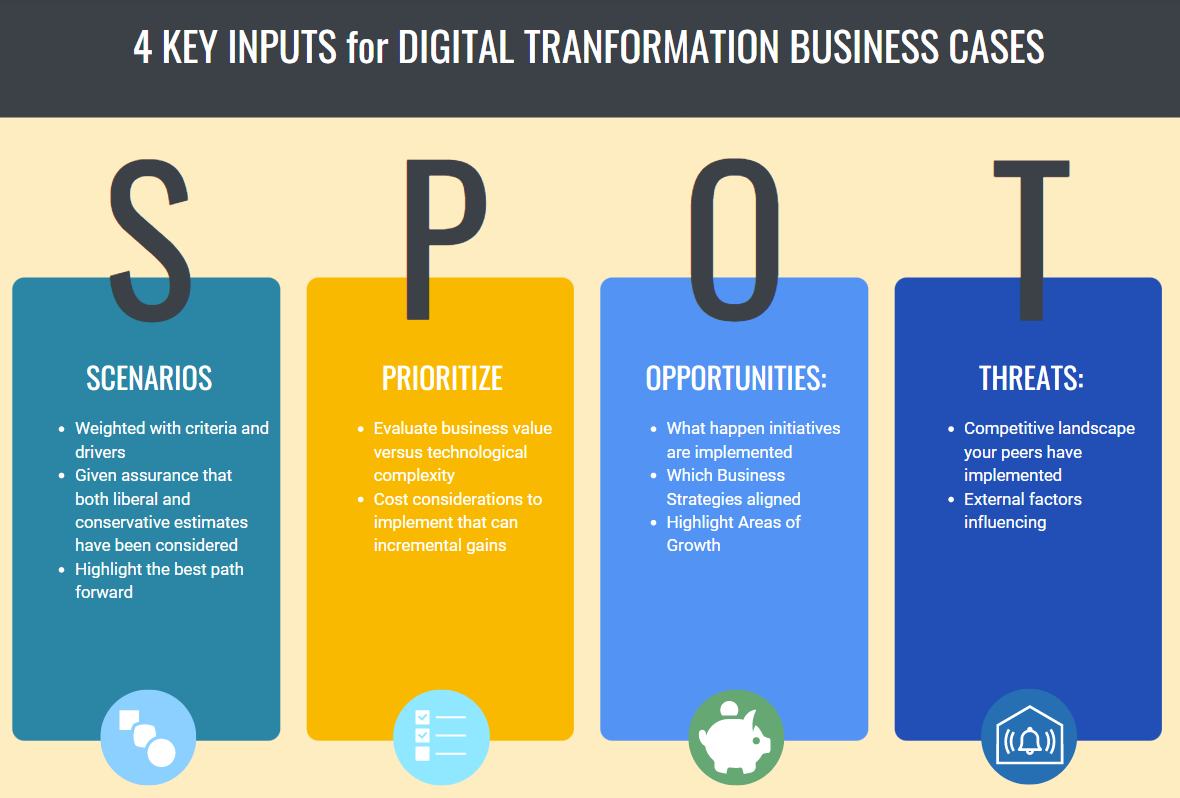Tailor Business Cases for Digital Transformation

Running a business in a technological era is exciting, however tough to keep up with. It seems like everyone and their neighbor has the latest and greatest when it comes to maintaining a technological edge. Landscape shifting services and products are everywhere. It may be a new app like Uber Eats, that has shifted the business model while improving customer satisfaction, or a new product that gets created through an advanced predictive ML model to detect fraud. Wouldn’t it be great to have insights handed to your team using an analytical model that you wouldn’t be able to arrive at alone? It’s about simplifying your decisions. But how do organizations start? How can you persuade others to join in and move toward the path of innovation? These initiatives are typically not easy to articulate in a business case – the ROI can be tough to calculate. However, there are some best practices that are now tried, tested and true. These best practices can apply when creating a business case for digital transformation. Let’s explore those best bet approaches.
There are many challenges when you decide to work toward digital transformation. Roadblocks like unsuccessfully achieving buy-in or support from your team can totally hinder your transformation objectives. Other barriers include technological limitations, shifting culture and the inability to curate information into one access point. Starting with what to solve for and getting buy-in to support the initiative is an important step.
Identifying the business outcomes that can be solved with advanced analytics and data science is typically the toughest part. There are actually ways to make this fun, and also arrive at a business case to socialize more broadly. Building specific business cases where there is high business value, with an understanding of where to start and where you want to go is always a good way to make the case. Most organizations have both long- and short-term strategies in place. Where it can get tricky is where to align to that strategy. Determine where the quickest and highest value resides and target that while also building toward a strategy that your stakeholders are focused on.
How can seemingly massive transformations be quickly achieved using advanced analytics and data science? How can a case be made to pursue multi-year transformation initiatives? How do you decide whether to make significant investments or spend on specific initiatives? Will these achieve saving or revenue generation with a high level of confidence? Let’s look at the key factors to include in your digital transformation business cases:
Scenarios: These should be built into your ROI calculations. There are a lot of what-ifs when embarking on a digital transformation. With a build in range of success you are progressing with an R&D mindset. With scenarios outlined you have a plan that you can build upon and you can grow into more advanced initiatives as momentum builds. Whether there is a 10x growth or a fail fast moment, these need to be considered as part of your approach.
Prioritization: Based on business value as well as technical complexity. This is easier said than done. There are multiple methods for weighing criteria that require input both from business and technical team members to arrive at a balanced score. It’s wise to conduct a first pass, produce a lite score and then involve more people to focus on further details in support of a business case.
Opportunity: Highlight the benefits of the proposal in relation to the business strategy. Consider external factors and involve a peer group.
Threats: The inverse to opportunity is also important to highlight. Understand your market and whether you are leading, bleeding or in the middle. What are peers in the industry doing and how can these goals be achieved? Also, external threats like global warming, economic factors and health considerations all need to be factored in for consideration.
Integrating these key elements into your business cases are a tried and tested way of getting more success. Yes, it will take some focus – looking inward to consider the factors specific to your organization and outward into the wider space that impacts your business. However, the results will be meaningful and allow for measurement of how precisely you’ve achieved your goals.
Share this
You May Also Like
These Related Stories

Metadata-Driven Data Governance: the How and Why

Navigating Change During an M&A

No Comments Yet
Let us know what you think